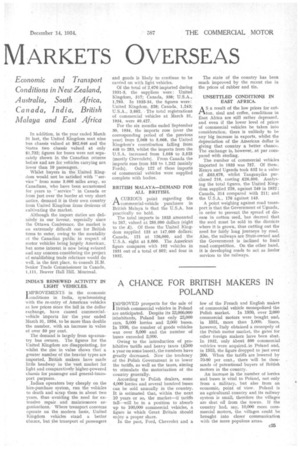A CHANCE FOR BRITISH MAKERS IN POLAND
Page 79

If you've noticed an error in this article please click here to report it so we can fix it.
IMPROVED prospects for the sale of I British commercial vehicles in Poland are anticipated. Despite its 33,000,000 inhabitants, Poland has only 23,000 cars, 5,000 lorries and 2,000 buses. In 1930, the number of goods vehicles was over 8,000 and the number of buses exceeded 3,000.
Owing to the introduction of prohibitive tariffs and heavy taxes (£500 a year on some buses), the numbers have greatly decreased. Now the tendency of the Polish Government is to lower the tariffs, as well as the taxes, aiming to stimulate the motorization of the country generally.
According to Polish dealers, some 4,000 lorries and several hundred buses can be sold annually in the country. It is estimated that, within the next 10 years or so, the market—if' tariffs fall—will be in a position to absorb up to 100,000 commercial vehicles, a figure in which Great Britain should enjoy a proper share.
In the past, Ford, Chevrolet and a
few of the French and English makes of commercial vehicle monopolized the Polish market. In 1930, over 2,000 commercial motors were bought and, in 1931, more than 1,000. Since, however, Italy obtained a monopoly of the Polish motor market, the gates for other foreign makers have been shut. In 1932, only about 500 commercial vehicles were acquired-in Poland and, in 1933, the figure dropped to just over 200. When the tariffs are lowered by 70-80 per cent., there Will be thousands of potentional buyers of British motors in the country.
An increase in the number of lorries and buses is vital to Poland, not only from a military, but also from an economic, point of view. Poland is an agricultural country and its railway system is small, therefore the villages are shut off from the towns. If the country had, say, 10,000 more commercial motors, the villages could be brought into closer communication with the more populous areas.




































































































































































